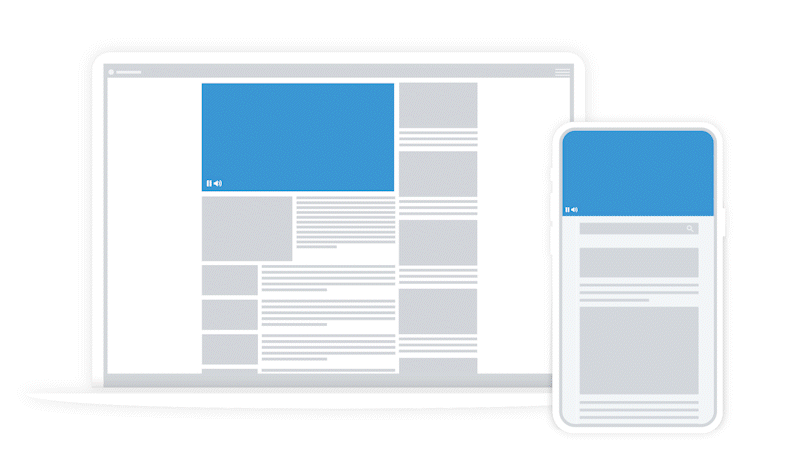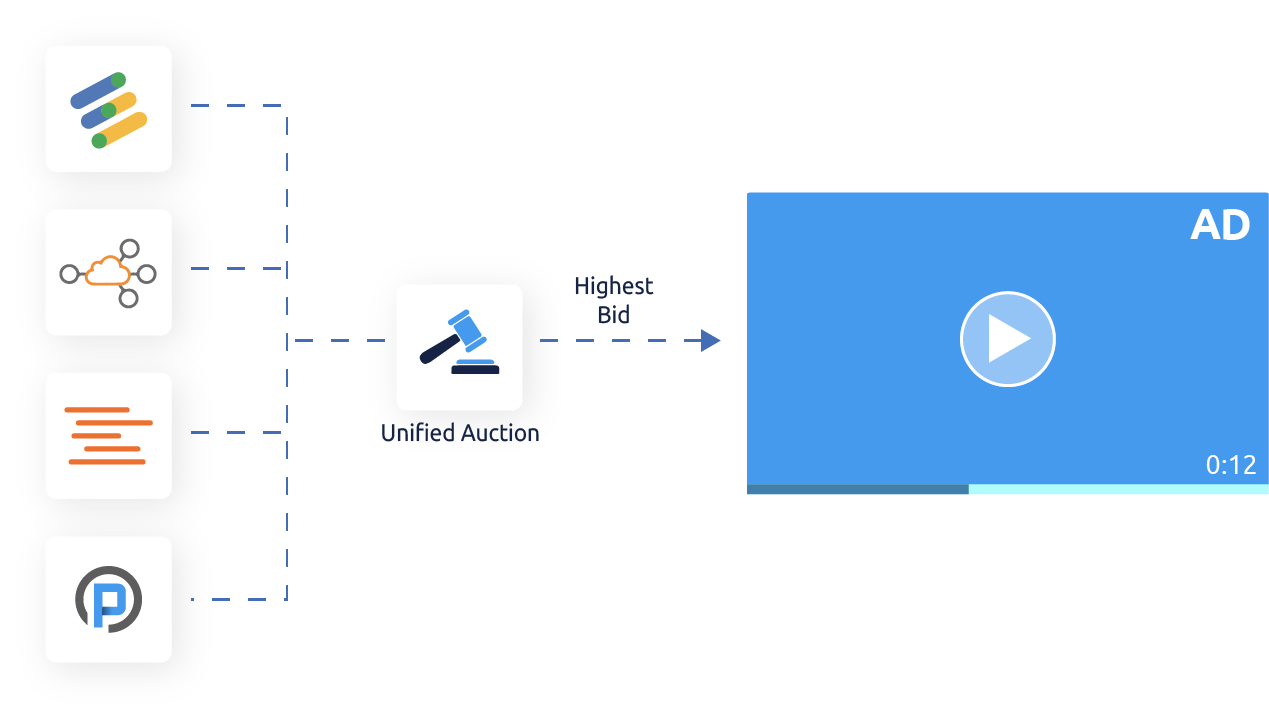The Guide to video ads for web + app Publishers
Get a PDF copy of the guide using the form below, or scroll down to read the entire guide right on this page.

Don't Have Time To Read the Entire Guide Now?
We'll email you a downloadable PDF version of the guide and you can read later.
All of our content is generated by subject matter experts with years of ad tech experience and structured by writers and educators for ease of use and digestibility. Learn more about our rigorous interview, content production and review process here.
Built with the expertise of:
INTRODUCTION
The play button - that little white or black arrow pointing to the right - is now as universally recognized as the check mark, the peace sign and virtually any other symbol you can think of. There’s a good reason for that: it means you’re about to watch a video, and people love video. In fact, 85% of people in the United States watch online videos every week, and 500 hours of video are uploaded to YouTube every single minute.
This isn’t news to publishers. Whether you run a website or a mobile app, you’ve probably been told a few too many times that video is the future of content. But do you know how much revenue you could be pulling in with video advertising? All that video content has to be monetized somehow, and video ads are the way to do it.
That’s the subject this guide will examine in great depth - video advertising for web and app publishers. Grab a cup of coffee and settle in, because there’s a lot to know about video ads.
Maximize your Revenue
Playwire helps publishers maximize their revenue. Video advertising is a key part of our offerings and revenue-growth strategies. If you’re ready for a turnkey video solution that can send your revenue skyrocketing, reach out to us.
table of
contents
Video Advertising by the Numbers

When it comes to reactions to video advertising, publishers can be broken down into two basic groups: those whose eyes light up when they hear about video ads and those whose eyes glaze over. That second group is often worried about the time, effort and investment it will take to break into video ads.
If you’re in that group, these numbers are for you:
- Two hours and 29 minutes. That’s how long the average adult in the U.S. will spend viewing online video content every single day.
- $12.5 billion. That’s how much experts predict advertisers will spend on direct-sold digital video advertising in 2024.
- $43 billion. That’s the expected ad spend for programmatic video ads in 2022.
- $18 billion. This is the projected advertising spend for mobile video in 2021.
- 72%. That’s the percentage of people who say they would prefer to learn about a new service or product via video instead of text.
Those are just a handful of the stunning numbers behind digital video advertising. (You can see more of them here.) If you’re not a math person, let’s boil these video advertising statistics down to a few words of summary:
For publishers, there’s a nearly endless amount of money and growth potential in video ads.
Benefits of Video Ads for Publishers

As we discuss the benefits of video ads for publishers, it’s important to note that video advertising isn’t an on-off switch, with “on” being those who do video ads and “off” being those who don’t. There are actually three camps:
- Those who do not do video ads
- Those who do video ads
- Those who do video ads the right way
As this guide will reveal, video advertising is a vast and complicated world. There are dozens of ways to do it wrong and only a small number of ways to do it right. So, even if you’re already doing video ads, you may yet have benefits to gain by changing your strategy or working with a partner who can do it the right way for you.
The benefits of video ads below apply only to cases in which the publisher is doing these ads the right way:
- Quality control. Because video ads cost advertisers more money, only serious advertisers do it. This creates a natural ad quality control filter for publishers. By selling video ad inventory, you’re eliminating the vast majority of spammy ads you often see in display advertising.
- More impressions to sell. If you’re using a video player and have a lot of video content, you can easily get 10 or 20 impressions out of one user in one session. Autoplay keeps the video content coming, and the ads keep playing.
- Videos drive conversions. Publishers who don’t use video average conversion rates of around 3%. For publishers who do use video, it’s 5%. It’s simple: higher conversion rates make your inventory more attractive to advertisers.
Why Aren’t More Publishers Doing Video Ads?
So far, we haven’t said one negative word about video content or video ads, so it’s probably obvious that we’re big fans. But the benefits are clear, so why isn’t every website and app publisher capitalizing on video?
This needs to be said unequivocally: publishers who aren’t doing video advertising are going to get left behind. Those who have so far resisted video typically cite the same reasons:
They’re Worried About Technical Challenges
It’s understandable to worry about the technical aspects of adding video in general, but when you add video ads to the mix, the thought can be overwhelming. Getting a video player onto the site, managing ad exchanges and finding programmatic and direct demand is a lot to ask of a busy publisher. And that doesn’t even include the work of creating video content.
The good news for publishers who find themselves worrying about the technical challenges of video advertising is that they don’t have to. Cutting-edge video partners like Playwire can handle every part of the process - content creation included.
They’re Worried About the User Experience
Videos tend to be heavy assets. Done wrong, they can bog down any site or app. Slower load times can severely damage the user experience (UX). UX always matters, but videos don’t always have to weigh down the sites or apps they appear on. Lightweight and agile video players can easily serve video ads and play videos without affecting page speed at all.
Then, of course, you have the part of UX that’s harder to control: the people who love your content and will object to any changes or new advertising methods (we often refer to these as the vocal minority). Unfortunately, someone will always complain about changes like this. But with a good balance between high-quality content and healthy ad frequency, you can manage this UX concern with little impact to your overall audience.
They’re Worried About the Cost
Videos are expensive, right? Absolutely, if you make them in-house with a full-time team and equipment you purchased. The cost of creating video content to monetize with ads can certainly be high, but creating your videos in-house is simply one option - not the only option.
At Playwire, we solve this little problem by making vertical-specific videos for our publishers to use every day. If your site is about gaming, you can play videos about gaming that will be interesting to your audience. And you can run ads with those videos.
Types of Video Ads

All video ads are videos. That much is obvious. But there are many types of video ads. Most of them are defined by their placement within your site or app - whether it’s in a dedicated video player, embedded within your content or somewhere else. Let’s dive in.
In-Stream Ads
Linear in-stream ads are those that play before, during or after your video content, so the question is less about where you want to run video ads and more about when. Nonlinear in-stream ads are usually not videos, but they run alongside or within video content without taking over the entire viewing experience for the user.

Pre-Roll Ads
The types of linear in-stream ads are relatively easy to understand based on their names alone. Pre-roll ads, for example, play before your main video content rolls. These are a relatively consistent favorite among publishers for two reasons:
- Users who want to watch one of your videos are usually motivated enough to sit through a few seconds of a video ad in exchange for viewing the content.
- That motivation yields better overall metrics, such as video completion rate, which translate to higher revenue.
If you’re worried about UX, pre-roll may be a solid option. Among mobile and desktop viewers, only 17% said pre-roll video ads disrupted their experience with the website or app they were using. For reference, that is a lot lower than the numbers for mid-roll and post-roll ads.
Mid-Roll Ads
These ads play somewhere between the start and end of your video content. The exact placement of mid-roll ads is often critical to their success. Place them too late in the video, when the user has seen much of what they wanted to see in the content, and they’re not likely to be watched. On the other hand, if you place them too early, the user may feel that the rest of the experience isn’t going to be worth the time the ad takes.
The correct placement and frequency of mid-roll ads can lead to high completion rates. It’s often helpful to play around with placement to see what works best for your platform and target audience.
Post-Roll Ads
Post-roll ads run after your video content is complete. Immediately, you may see a potential problem. Who’s going to stick around after the content to watch an ad? It’s like sitting through the entire credits at the movie theater.
Some people do stick around after the credits, of course, but not that many. But what if the movie was a double feature? More people would stick around for the credits if another movie was going to begin immediately after. You can recreate that effect by allowing your video player to autoplay related video content after the completion of a video.
In-Content Video Ads
Video advertising doesn’t have to be limited to video content. Video ads that run independently of any accompanying video content are called in-content video ads.
These ads still require some kind of video player, of course, but they can appear in various places on your site.
In-Article Video Ads
If you’re a publisher of text-based articles who wants to run in-article video advertisements, you can dedicate a large portion of any article page to a video player that runs ads. As the page loads, so does that video player. A video ad initiates, and when the user scrolls past the point of being able to see the original video player, the in-article video can detach from its location and dock to another part of the page to follow them as they read.
Corner Video Ads
With corner video ads, you can skip the part where the ad jumps from its original location and docks to the corner of the screen. You can simply have the ad live in a corner of the page, where it won’t obscure the user’s view of the content they came for. Like in-article video ads, corner video ads are meant to follow the user as they read or scroll.

Sidebar Video Ads
Most websites have a sidebar filled with navigational links, related content, publisher information and similar items. You can utilize that real estate for something a little more valuable: video advertising.
Similarly to a corner video ad, the sidebar video ad initiates on page load and pops out to dock to the corner when the user scrolls beyond the sidebar.

Pre-Content Video Ads
We have coined a term for another type of ad that doesn’t fit perfectly into either of the broader in-stream and in-content video ad categories. It’s called a “pre-content” video ad.
This ad type gets a special shout-out here because it can be highly effective. The idea is that you place a video ad in front of something the user really wants to see. It could be a valuable download or a game the user wants to play in a mobile app or even on a desktop gaming website. In any case, the user must watch the video ad in order to gain access to the content.
Other Video Ad Types
With the categories we have covered so far, we have mentioned the most popular types of video ads. However, there are a few other types of video advertising that deserve some attention.
Rewarded Video
Most common in mobile apps, rewarded video ads add an extra layer of motivation for the user to watch them. The incentive is a reward of some kind.
This can work in a lot of different ways, but one of the most common use cases is in mobile gaming. For example, if you are the publisher of an app that houses a platform game or first-person shooter, you could place a rewarded video ad immediately between the moment when the user loses their last life and the moment the game ends. The reward? An extra life.
Extra lives are an easy example, but you could offer a lot of things: in-game currency, special items, or, outside of gaming, discounts on products or services.
Video Companion Ads
These aren’t exactly video ads, but they deserve inclusion on this list because they accompany video advertising. A video companion ad is a display ad that appears alongside or within a video player.
Picture a video player hosted on your website. There is some visual real estate along the bottom, top and sides of the square the player occupies. If you place an ad in one of those places, you have a video companion ad on your hands. In real-world uses, these ads often complement a linear in-stream ad from the same advertiser.
Another example of a video companion ad is the in-video banner. While your video content is playing, a small banner pops up along the bottom of the video but still within the video frame.
Interstitial Video Ads
Interstitial video ads share many qualities with pre-content video advertising. But instead of appearing directly before the content, they appear in between the phases of use of an app or website.
This ad unit, which will take up the entire screen, is most common in apps. It might appear between, for instance, levels of a game or between the point where the user initiates the game and the point when the game begins.

In-Banner Video Ads
It’s important to begin the discussion of this video ad type with a caveat: in-banner video ads are generally frowned upon in the advertising industry. That’s why Playwire doesn’t work with in-banner video. Still, this type of ad is worth covering so you can have a full understanding of what’s out there and some of the problems you can encounter with this type of inventory.
An in-banner video ad appears inside a display banner. These ads don’t use a video player. Instead, they live where a display ad would normally live. What’s the problem? From an industry standpoint, this is seen as a way to try to sneak a video cost per mille (CPM) inside a display impression. Beyond that, there are a few other issues with in-banner video:
- They’re bad for UX. That’s because users are not expecting a video ad inside a banner. These ads often play when the user’s cursor hovers over them, so an accidental hover over a banner video ad is going to trigger an unwanted ad.
- They’re heavy. Dedicated video players are built for speed when playing video, meaning they aren’t supposed to slow your site down. But banners are not built that way, so when they house a video, they can significantly reduce your page speed.
- Google doesn’t like them. These kinds of ads go against Google’s best practices for advertising. The last thing most publishers want to do is upset Google.
Fortunately, there are enough alternatives to in-banner ads to give you plenty of options without having to resort to this method.
Selling Video Inventory: Direct vs. Programmatic

You’re never going to get video ads on your website or app if you don’t sell video ad inventory. But how, exactly, are you supposed to do that? You can do it in two main ways: direct sales and programmatic sales.
Direct Video Ad Sales
Direct selling of video ad space on your app or site is probably going to feel very similar to the direct selling of any insertion order (IO) buy. The publisher and advertiser interface more or less directly, with the exception of ad sales partners and agencies who may be in the middle. The sale hinges on many of the same metrics that the sale of any other type of ad would: your audience, your brand awareness, your sway with particular demographics, and similar components.
Keep in mind that the competition for direct demand in the video advertising space is steep. Tons of publishers are doing video, and even those with significant reach may struggle to convince major brands that their inventory is worth the investment while social media, YouTube ads, and similar platforms gain market share.
Despite the competition, the payoff is big. Landing those direct big-brand dollars is going to increase revenue more than almost any other effort.
Programmatic Video Ad Sales
Programmatic advertising automates many of the aspects of the traditional advertising process, although humans still have to be involved. Programmatic advertising automatically auctions every impression on your site or app. Bidders compete for the impression, and the winner gets their ad served to the end-user. (If you would like to learn more about programmatic advertising, check out our in-depth programmatic advertising guide.)
This technology was born before digital video advertising had hit its stride, but today, it applies as much to video as it does to display. There are some pretty technical aspects to setting up programmatic advertising on the publisher side (unless you team up with a programmatic partner like Playwire), but once it’s set up, it can get you access to broad demand for your video inventory.
At first glance, it may be hard to understand how direct sales can compete with programmatic at all. The biggest downside of programmatic advertising, however, is that it involves a relatively large number of middlemen, and they all take a cut. That means that, while you may get broader demand through programmatic, direct sales are likely to be of more value per impression to you.
Best of Both Worlds
The nice thing is that you don’t have to choose between programmatic video ad sales and direct video ad sales. You can - and probably should - do both. Of course, managing just one of these areas can be a lot to ask of a publisher who is trying to make great content. That’s why so many publishers team up with ad partners who can take care of these things for them.
Understanding the Video Advertising Process

As fun as it would be if this were true, you don’t just decide you want to do video advertisements and then wish them into existence on your website or app. There’s a process, and each part of it has to function well if you hope to maximize your revenue.
Below, we’ll examine the pieces of the video advertising puzzle, what takes place every time a video ad is served, and the video ad metrics you will want to pay attention to.
Components of Video Advertising
A car is a single object, but it contains many parts that come together to make it run. Video advertising is the same way. It’s a concept - a revenue-driving one - but it’s made up of several key components. These include the following:
- A video player on your site or app
- The ad networks you work with
- The servers that actually put the ads where they need to be
Video Player
Everybody is familiar with video players. The YouTube video player is perhaps earth’s most common lens through which digital video is viewed. But don’t let your familiarity with and apparent simplicity of the video player fool you - it’s an incredibly important piece of technology involved in video advertising.
At the risk of over-explaining, a video player is an interface you use to watch an online video. It usually has basic controls that can play or pause the video, as well as a video quality menu and an option to initiate closed captions. You pretty much have to have one of these things on your app or site if you want to do video ads.
If you have a lot of technical expertise, you might be able to create your own. This is going to take some time, and any complications are going to be your responsibility to address. Alternatively, you can get a third-party video player from some video ad networks, and a few high-end video advertising partners provide their own.
The goals for the video player you use should include the following:
- Lightweight code that won’t slow down your site
- The ability to upload your own content (if you are running third-party content for in-stream ad placements)
- The ability to autoplay videos after the end of the target video
- Docking functionality that allows the player to dock to the corner of the user’s screen
- Easy implementation that allows you to get the player on your site without too much development work
Video Ad Networks
Your shiny new video player is sitting on your site or app, but it’s lonely. It doesn’t have any ads. That’s because you haven’t generated any demand for your video inventory yet. Video ad networks are how you do that.
These networks compile demand from enormous lists of advertisers, and once you’re approved in one, you get access to that demand. There are a ton of these networks, and while there is a benefit to working with multiple video ad networks, you won’t have the time or bandwidth to work with all of them.
With that said, what makes a good video ad network? Here are some key qualities to look for:
- Access to broad, consistent advertiser demand
- Protection from impression fraud
- Easy-to-access, real-time performance analytics
Video Ad Servers
Your video ad server is going to do a lot of the heavy lifting of video advertising for you. Servers can serve the ad creative, process programmatic auction results, manage your ad campaign, and provide analytics. Some larger publishers have the resources to create their own video ad servers, but smaller and mid-sized publishers more often go the third-party route.
How Video Ads Appear on Websites and Mobile Apps
We have listed the basic components of video advertising, but we haven’t quite covered how they all come together. This process will vary somewhat by circumstance - whether you’re doing header bidding and programmatic, what kinds of video ads you’re serving, and where you are holding auctions for your inventory will change the details of the basic video advertising process.
The basic steps of video advertising are as follows:
- A user loads your site or app.
- Your video player calls your server to retrieve the video content.
- The server sends the information the video player needs to retrieve the proper video.
- Your video player sends a request to your ad server for ad creative. (This is where the many steps of programmatic advertising are simplified, but the end result is that the server sends the markup for the chosen video ad to your video player.)
- The video player sends a request for the ad creative to the advertiser’s server.
- The advertiser’s server returns the location of the ad, which the player retrieves and displays for the user.
Those six steps all take place in a fraction of a second, and they repeat every time a new user initiates the process by loading your app or website.
Measuring Success: Video Advertising Metrics
Whether you’re completely new to video advertising or have been doing it for a while, you really need to understand what success looks like if you want to push your video advertising revenue higher. These metrics will help you measure your video advertising efforts:
- Video viewability. Viewability measures whether and how long ads are being seen on average. If your video ads load and play automatically, you might assume that your viewability will be 100%, but that’s not quite right. There’s a specific standard for video viewability: at least half of the video player must be in view for two seconds or more. On average, viewability for video ads is around 66%.
- Video completion rate. This metric examines how many people watch an ad from start to finish. This is most often displayed as a percentage, measuring the number of people who finished the ad versus the number of people who started it but didn’t finish.
- Click-through rate. You’ve more than likely heard of click-through rate (CTR) in terms of display advertising, but it applies to video, too. It measures the percentage of video ad impressions that end with a user clicking on the ad.
- CPMs. We’ve already mentioned CPMs a couple of times in this guide, and that’s because this is the metric that tends to matter most to publishers. It’s the price you’re getting for every 1,000 video ad impressions. Higher CPMs tend to lead to higher overall revenue.
- Time spent. This metric is similar to video completion rate, but it doesn’t require that the user completes the video ad. Instead, it simply measures how much time users spent viewing the ad overall.
- Demographics. This isn’t as much of an ad performance metric, but demographic information about those who view video ads on your website or app is extremely important. That’s because advertisers often want to target particular demographics. If you have access to that demographic, you stand a good chance of getting some of those advertising dollars.
Why do these numbers matter to publishers? Because they provide data that can convince advertisers to buy inventory from you. If you have a high video completion rate, for example, advertisers who hold that metric in high regard are going to be much more likely to do business with you.
Video Advertising for Publishers: Best Practices

It’s pretty difficult to find a publisher who doesn’t want to maximize their revenue. Those who break into video advertising are taking a step in the right direction, but to truly maximize their revenue, they have to not just do video advertising, but do it right.
To help, we break down some of the best practices for video advertising below. Many of the best practices for website publishers will overlap with the best practices for app publishers, but it’s important to note that there are some small, platform-specific distinctions to pay attention to.
Here are the best practices:
- Provide relevant content. In the early days of video advertising, you could often find publishers running videos of completely irrelevant content just so they could play ads before, during, and after. That’s not helpful, and it’s no way to engage an audience. Instead, provide engaging video ads that are relevant to your vertical.
- Keep it muted. This is a must. Do not let video ads autoplay with sound on your website or app. Autoplaying video ads with audio is harmful to UX and can even get your ads filtered by certain web browsers.
- Make it easy to close. Nothing frustrates web or mobile users more than being unable to close a video ad that is blocking their view of the content they want to see. Make sure the process for closing the ad is both obvious and functional.
- Keep it outside of the viewport. In general, you don’t want to have a video ad blocking any part of the content your users are trying to engage with. Doing so will usually result in a quick close, meaning your viewability and video completion rates go down, and harm UX.
- Dock it. To promote higher viewability and completion rates, you should invest in a video player that can dock to the sidebar or corner of the page when the user scrolls past the ad. Docking typically only applies in desktop scenarios, but Playwire has created top docking that mobile publishers can take advantage of.
- Optimize for video size. Play around with the size of your video player and video ad format. The size considerations are wildly different for desktop and mobile advertising, so keep that in mind. But also keep in mind the unique details of your site or app. You want the ad to be viewable, but you don’t want it to overwhelm the user.
- Do header bidding. We won’t get too deep into header bidding in this guide, but you can click here to learn more about it. Put simply, header bidding is an auction method for ad inventory that gets you the highest bids every time. There’s really no reason not to do this if you’re wanting to get the most out of your video ad campaign.

Video Advertising Platforms: Are They Worth It?

With all the moving parts, all the considerations, and all the technology involved, video advertising can start to feel overwhelming pretty quickly. In many cases, the DIY approach to video ads is filled with long timelines, delays, and technical difficulties. Early on, those frustrations opened the field for video advertising platforms.
These platforms claim to provide turnkey video advertising solutions for publishers. They often will handle the setup and implementation, as well as optimization for higher revenue. But are they worth it?
The answer to that question will depend on your individual situation, of course, but at Playwire, we work hard every day to maximize video ad revenue for publishers. This requires an enormous amount of effort and a willingness to attack the issue from several angles. Here are some of the ways we do that:
- We have built a cutting-edge video player that is lightweight and allows publishers to upload their own content.
- We create high-quality video content for multiple verticals every day.
- We dedicate an account manager and solutions engineer to every publisher. These professionals never stop optimizing your site or app for maximum revenue, from video ads and other sources.
- We provide world-class analytics and reporting that allow you to see exactly what is happening with video ads on your site.
- We maintain a worldwide direct sales team to bring in high-dollar direct buys to complement programmatic buys.
- We partner with hundreds of publishers in multiple verticals, and we use the data we get from those partnerships to inform revenue strategies for new publishers we take on.
Are video advertising platforms worth it? Some are, and some aren’t. But we know Playwire is - we’ve seen our technology and strategies pay off for publishers countless times.
Related Content

Feel free to visit our Complete Video Advertising Resource Center, or dive deeper into any of these related articles:
- What are Rewarded Video Ads?
- The 8 Best Video Advertising Platforms in 2023
- 5 Video Advertising Techniques Publishers Should be Using
- 10 Video Advertising Stats to Know
- Why Video Advertising Works: Taking Advantage of Video Advertising Revenue
- Why You Don't Want to Use In-Banner Video Ads
- 7 Benefits of a Video Advertising Platform
- 5 Mobile App Video Advertising Tips
- Increase App Revenue with Mobile App Video Ads
- Video Ad Types: In-Stream Video Ads, Outstream Video Ads
- Getting Video Ads on Your Website
- Why Is Video Advertising So Hard for Publishers?
- What Are the Benefits and Challenges of Video Ads?
- The Unexpected Benefits For Publishers When Adding Video
- New Ad Unit! Web Rewarded Video Ads
- Increase Paywall Subscription Revenue with Rewarded Video
Playwire: Leading the Way Forward in Video Ads for Publishers
Video advertising is more than a buzzword. It’s the future for publishers who want to maximize their revenue. Because Playwire is in the business of maximizing revenue for publishers, video advertising is a huge part of what we do. And we do it really well.
If you’re ready to see it for yourself, just contact us online.
Amplify
Your Ad Revenue
Accelerate your business and uncomplicate your ad tech stack, because you deserve a partner and a platform that demands more for you.

